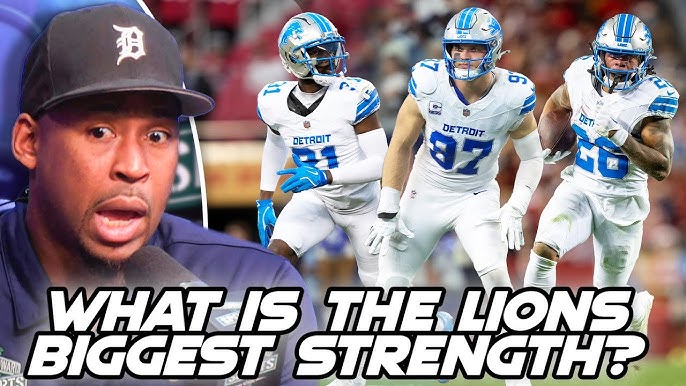The ‘aggressive’ secondary demonstrates its potential to be one of the most significant strengths of the Detroit Lions.
The Detroit Lions have long been a team searching for identity and consistency, especially on the defensive side of the ball. However, one aspect of their defense that has recently shown tremendous promise is the aggressive nature of their secondary. This aggressive secondary could very well become one of the most significant strengths for the Lions moving forward. It embodies a shift in philosophy, blending pressure, physicality, and smart playmaking to create a disruptive force that can change the complexion of a game. To understand why this aggressive secondary has such potential, it’s important to delve into the specific attributes of the players, the coaching strategies, the impact on the team’s overall defensive scheme, and how this approach compares to other units across the league.
First, the players themselves deserve attention. The Lions’ secondary is composed of a group with diverse skills but a common thread of fearlessness and tenacity. When a secondary embraces aggression, it means they are not content to simply react to offensive plays; they actively seek to disrupt routes, force mistakes, and create turnovers. The Lions’ defensive backs have demonstrated this by consistently pressuring receivers at the line of scrimmage, jumping routes, and jumping into passing lanes. This kind of play requires confidence, speed, and an ability to read the quarterback quickly, all qualities that the Lions’ secondary members have shown signs of developing or already possess.
One standout player who exemplifies this aggressive approach is cornerback Jeff Okudah. Despite his early career challenges with injuries and adjusting to the speed of the NFL, Okudah has gradually grown into a formidable cover corner known for his physicality and ball skills. His willingness to challenge receivers and not shy away from contact embodies the aggressive mentality the Lions are fostering. Similarly, other members of the secondary like cornerback Amani Oruwariye and safety Tracy Walker have embraced a proactive style, often taking calculated risks to disrupt passing plays. These risks sometimes lead to penalties or getting beat, but the benefits of forcing turnovers or intimidating opposing quarterbacks often outweigh those costs. The presence of a talented safety like Walker also helps, as safeties play a crucial role in both coverage and run support, and an aggressive safety can act as a roving defender who steps up to stop runs or blitz from the secondary, further complicating offensive reads.
The coaching staff’s influence in nurturing this aggressive identity cannot be understated. Defensive coordinator Aaron Glenn has emphasized the importance of an aggressive secondary as part of the Lions’ defensive blueprint. His experience as a former defensive back and his track record of developing defensive backs have given him insight into how to cultivate this mindset. Glenn’s scheme allows and encourages defensive backs to press receivers, jump routes, and support blitz packages, blending man and zone coverages that confuse quarterbacks and limit their options. Glenn’s aggressive approach also aligns well with head coach Dan Campbell’s overall defensive philosophy, which emphasizes toughness, physicality, and playing with an edge. The coaching staff’s trust in their secondary to take chances has empowered players to play more freely, creating more impactful plays and establishing a tone that can wear down opposing offenses over the course of a game.
An aggressive secondary also brings strategic advantages that go beyond simply defending passes. By pressuring receivers at the line and jumping routes, the Lions can disrupt timing-based offenses that rely heavily on quick, short passes and precise route-running. This disruption can force quarterbacks into holding the ball longer, which in turn allows the defensive front more time to generate pass rush pressure. The secondary’s aggression complements the front seven’s efforts by forcing offenses into mistakes and limiting their ability to execute quick strikes. Additionally, an aggressive secondary is valuable in limiting big plays downfield, which is crucial for teams like the Lions that are building a defense that aims to be resilient and opportunistic rather than merely bend-but-not-break. This secondary has the potential to force turnovers and create short fields for the offense, a critical factor in winning close games.
In terms of team identity and culture, an aggressive secondary helps shape the entire defense’s mindset. When the defensive backs play with confidence and physicality, it instills a sense of fearlessness throughout the unit. This confidence can lead to more aggressive blitzing from linebackers and defensive linemen, knowing the secondary can cover effectively. The ripple effect of having a strong, disruptive secondary builds a culture of aggression and accountability, which can be transformative for a franchise like Detroit that has struggled defensively in recent years. Players on the defense feed off each other’s energy, and having a secondary that can generate turnovers and big plays boosts the entire team’s morale and competitiveness.
Comparing the Lions’ aggressive secondary to other top units in the NFL highlights the potential impact. Historically, some of the best defenses in the league have featured secondaries that play aggressively and generate turnovers. Teams like the Pittsburgh Steelers, Baltimore Ravens, and San Francisco 49ers have built their defensive reputations around secondary units that don’t just defend but attack. These units have consistently ranked among the league leaders in interceptions, pass deflections, and forced turnovers, often tipping the balance in tight games. For the Lions, adopting a similar aggressive secondary approach means they can compete against high-powered offenses and keep games within reach, even when the rest of the defense faces challenges.
The risks associated with an aggressive secondary do exist, and the Lions must manage those carefully. Aggression can lead to blown coverages, penalties, and giving up big plays if defenders are out of position. However, with proper coaching, communication, and disciplined technique, these risks can be mitigated. The key is balance—playing aggressive but smart. When the Lions can maintain this balance, their secondary becomes a formidable weapon that opponents must game-plan for extensively.
Looking ahead, the continued development of young players in the secondary, combined with smart coaching and strategic adjustments, could turn the Lions’ secondary into one of the league’s premier units. Draft picks, player acquisitions, and internal development all point toward building a unit that thrives on aggression, physicality, and playmaking. This secondary will not only improve the Lions’ defense statistically but also enhance the team’s competitiveness and identity.
In conclusion, the aggressive secondary of the Detroit Lions represents a fundamental shift in the team’s defensive approach, carrying the potential to become one of their most significant strengths. By cultivating a mindset of physicality, disruption, and risk-taking, the Lions’ defensive backs have started to establish a unit that can control the passing game, generate turnovers, and elevate the entire defense. With strong coaching, talented players willing to embrace aggression, and a culture that rewards toughness, this secondary is poised to be a game-changing element for the Lions, helping them rise as a formidable defensive force in the NFL.



